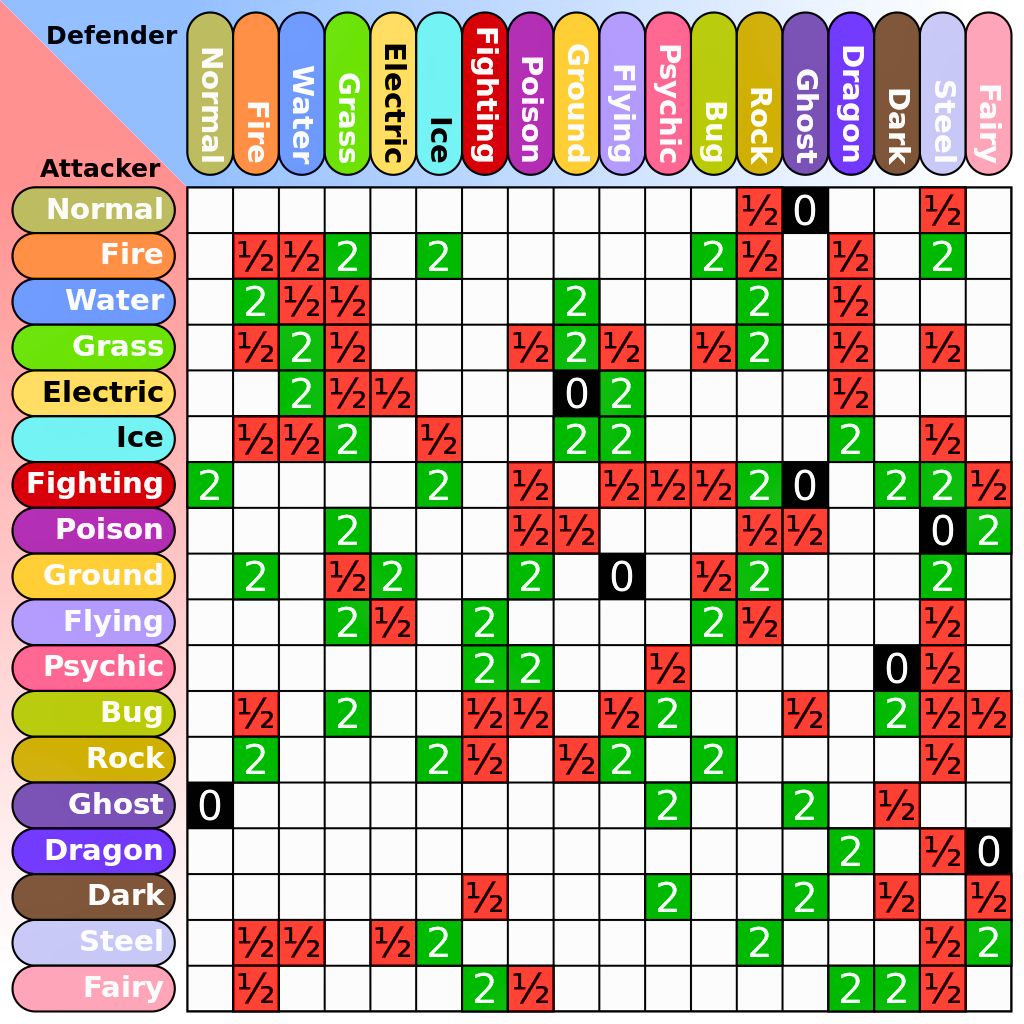In the Pokémon universe, 18 distinct types exist, each with unique interactions among themselves. This complexity often makes it challenging to keep track of all the possible type matchups and combinations, especially considering the prevalence of Pokémon with dual types. This added layer significantly complicates the Pokémon weakness chart, making it a daunting task to master.
Every Pokémon type boasts specific strengths, weaknesses, immunities, and resistances. Whether you’re looking to brush up on your understanding of how Pokémon types interact or seeking information on the performance of a particular type against others, this convenient Pokémon type chart serves as an essential reference tool.
Pokemon Type Chart

Before diving into the Pokémon type chart, it’s essential to familiarize yourself with a few key terms to grasp the mechanics of Pokémon type weaknesses fully.
- Super Effective Against: Indicates that attacks of a certain type will deal double damage to Pokémon of the types listed.
- Weak To: Specifies that Pokémon of a certain type will receive double damage from attacks of the types listed.
- Resists: This means that Pokémon of a certain type will only take half damage from attacks of the listed types.
- Weak Against: Implies that attacks from Pokémon of a certain type will cause half the usual damage to Pokémon of the listed types.
| Pokemon Type | Super Effective Against | Weak To | Resists | Weak Against |
|---|---|---|---|---|
| Bug | Grass Psychic Dark | Fire Flying Rock | Grass Fighting Ground | Fire Fighting Poison Flying Ghost Steel Fairy |
| Dark | Psychic Ghost | Fighting Bug Fairy | Psychic (No effect) Ghost Dark | Fighting Dark Fairy |
| Dragon | Dragon | Dragon Fairy | Fire Grass Water Electric | Steel Fairy (No effect) |
| Electric | Water Flying | Ground | Electric Flying Steel | Grass Electric Ground (No effect) Dragon |
| Fairy | Dragon Fighting Dark | Poison Steel | Fighting Bug Dark | Fire Poison Steel |
| Fighting | Normal Steel Ice Rock Dark | Psychic Fairy Flying | Bug Rock Dark | Poison Flying Psychic Bug Fairy |
| Fire | Grass Bug Ice Steel | Water Ground Rock | Fire Grass Ice Steel Fairy Bug | Fire Water Rock Dragon |
| Flying | Fighting Grass Bug | Electric Ice Rock | Fighting Grass Bug | Electric Rock Steel |
| Ghost | Psychic Ghost | Ghost Dark | Normal (No effect) Fighting (No effect) Poison Bug | Dark |
| Grass | Water Ground Rock | Fire Flying Bug Poison Ice | Grass Water Ground Electric | Grass Dragon Steel Bug Fire Flying Poison |
| Ground | Electric Fire Poison Rock Steel | Water Grass Ice | Poison Rock | Grass Bug |
| Ice | Grass Ground Flying Dragon | Fire Fighting Rock Steel | Ice | Fire Water Steel |
| Normal | – | Fighting | Ghost (No effect) | Rock Steel |
| Poison | Grass Fairy | Ground Psychic | Grass Fighting Poison Bug Fairy | Poison Ground Rock Ghost Steel (No effect) |
| Psychic | Fighting Poison | Bug Ghost Dark | Fighting Psychic | Psychic Dark (No effect) Steel |
| Rock | Fire Ice Flying Bug | Water Grass Fighting Ground Steel | Normal Fire Poison Flying | Fighting Ground Steel |
| Steel | Ice Rock Fairy | Fire Fighting Ground | Normal Grass Ice Flying Psychic Bug Rock Dragon Steel Fairy | Fire Water Electric Steel |
| Water | Fire Ground Rock | Grass Electric | Steel Water Fire Ice | Water Grass Dragon |
How Do Multipliers Work?
The Pokémon weaknesses chart is essential for understanding battle dynamics. It outlines the damage multipliers that determine the impact of each attack.
Damage multipliers come into play in several scenarios, notably when a Pokémon possesses dual types that share a common weakness or when its combination of types alters its vulnerability to certain attacks.
Take, for instance, Swampert, which is both Ground and Water-type. This Pokémon would sustain quadruple damage from Grass-type moves, given that both Ground and Water types are vulnerable to Grass.
Immunities are another critical aspect. A Pokémon’s immunity to certain types remains unaffected by its secondary type. For example, Normal-type Pokémon are immune to Ghost-type attacks, so a Pokémon that is both Normal and Flying-type retains its immunity to Ghost attacks.
When a Pokémon’s dual types include one weak to a particular type and another resistant to it, the Pokémon receives standard damage. Consider Swampert again: it would ordinarily take double damage from Electric-type moves due to its Water typing. However, because its Ground-type completely nullifies Electric damage, Swampert remains unaffected by Electric-type moves.
Calculating the damage a Pokémon will take involves multiplying each type’s damage multipliers (e.g., 0.5x for resistance, 2.0x for weakness). This calculation gives you the overall damage multiplier for any attack against that Pokémon.
With an understanding of weaknesses, immunities, and how to calculate damage multipliers, you’re now fully equipped to navigate the Pokémon type chart effectively.
- Reladyne Nova 1050 Engine: Starfield - April 30, 2024
- Reladyne Nova 1040 Engine: Starfield - April 30, 2024
- Reladyne Supernova 2000 Engine: Starfield - April 30, 2024


